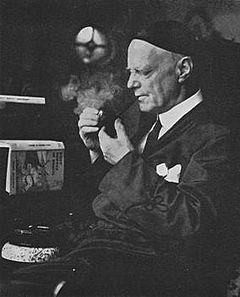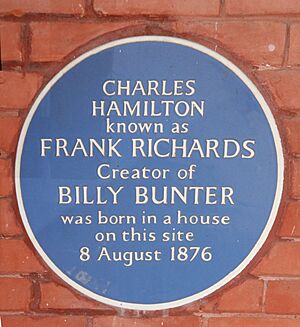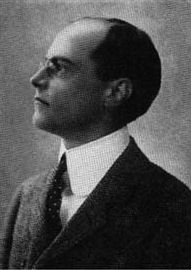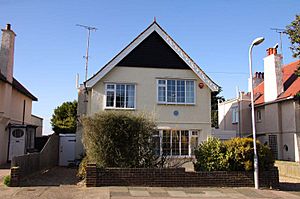Charles Hamilton (writer) facts for kids
Quick facts for kids
Charles Hamilton
|
|
|---|---|

Charles Hamilton
|
|
| Born | Charles Harold St. John Hamilton 8 August 1876 Ealing, London, England, UK |
| Died | 24 December 1961 (aged 85) Kingsgate, Kent, England, UK |
| Occupation | Author |
| Nationality | English |
| Notable works | Billy Bunter |
Charles Harold St. John Hamilton (born August 8, 1876 – died December 24, 1961) was a famous English writer. He was known for creating long series of stories for weekly magazines. These stories often featured the same characters.
He was especially famous for his school stories, but he wrote about many other topics too. Charles Hamilton used different pen-names for each set of characters. His most well-known pen-name was Frank Richards, which he used for the Greyfriars School stories, featuring the character Billy Bunter.
Other important pen-names included Martin Clifford (for St Jim's school) and Owen Conquest (for Rookwood school). He also wrote many stories under his real name.
It's believed he wrote about 100 million words in his lifetime! This amazing amount of writing earned him a spot in the Guinness Book of Records as the world's most prolific author.
Contents
Charles Hamilton's Writing Life
Early Years and First Stories (1876–1906)
Charles Hamilton was born in Ealing, London. He was one of eight children. He went to Thorn House School in Ealing, where he learned Classical Greek and other subjects.
He started his writing career very young. His first story was accepted almost right away in 1895. For many years, he was the main writer for a publisher called Trapps Holmes. He wrote thousands of stories for them. These included tales about police, detectives, firemen, Westerns, and school adventures.
In 1906, he began writing for Amalgamated Press. Even though he kept writing for Trapps Holmes until 1915, he slowly started focusing more on Amalgamated Press.
The Golden Age of His Writing (1907–1940)
In 1907, Amalgamated Press launched a new magazine for boys called The Gem. Soon, its main feature was a story about St Jim's school, starring Tom Merry. Charles Hamilton wrote these stories using the pen-name Martin Clifford.
The Gem quickly became popular. So, in 1908, a similar magazine called The Magnet was started. This one was about Greyfriars school, and Hamilton was the author again. For these stories, he used the name Frank Richards.
In 1915, Hamilton created a third school for Amalgamated Press, called Rookwood. He wrote these stories as Owen Conquest. They featured a character named Jimmy Silver and appeared in the Boys' Friend Weekly magazine. These Rookwood stories were shorter than the Greyfriars and St Jim's tales.
These three schools became the focus of Hamilton's writing for the next thirty years. They are the works he is best remembered for. At first, the St Jim's stories were more popular. But over time, the Greyfriars stories became his main focus. Many people consider the years 1925-1935 to be his 'golden period'.
By the late 1930s, fewer people were buying The Gem and The Magnet. In December 1939, The Gem stopped being published. The Magnet also stopped suddenly in May 1940 because of a paper shortage during the war.
Later Career (1940–1961)
After The Magnet closed in 1940, Hamilton didn't have much work. However, he became known as the author of these popular stories after a newspaper interview. He couldn't continue the Greyfriars stories right away because the publisher owned the rights.
So, he created new schools like Carcroft and Sparshott. By 1946, he was allowed to write Greyfriars stories again. He signed a contract for a series of hardback books. The first one, Billy Bunter of Greyfriars School, came out in 1947. This book series continued for the rest of his life.
He also wrote more St Jim's, Rookwood, and Cliff House stories. Plus, he wrote scripts for seven TV series about Billy Bunter for the BBC.
Charles Hamilton passed away on December 24, 1961, at the age of 86.
Charles Hamilton's Personal Life
Charles Hamilton never married. He enjoyed writing stories, studying Latin, Greek, and modern languages. He also liked chess and music.
He traveled a lot in Europe when he was younger. After 1926, he lived in a small house called Rose Lawn in Kingsgate, Kent, England. His housekeeper, Miss Edith Hood, looked after him.
Even though Hamilton became a bit reclusive later in life, he wrote many letters to his readers. He often wore a skull cap to cover his hair loss and sometimes smoked a pipe.
He had a close relationship with his sister Una and her daughter, his niece, Una Hamilton Wright. His niece wrote a book about him in 2006. He also got along very well with his brother-in-law, Percy Harrison.
He typed his stories on a Remington Standard typewriter. He used a purplish ribbon and made very few changes as he typed. Two of his old typewriters are still known to exist today.
How Much Charles Hamilton Wrote
It's thought that Charles Hamilton wrote around 100 million words. This is like writing 1,200 average-length novels! This makes him one of the most prolific authors ever. He created over 100 different schools in his stories. More than 5,000 of his stories have been found, and 3,100 of them were printed again.
Pen-names He Used
Charles Hamilton used at least 25 different pen-names. Here are some of them:
| Pen-name | Where it was used |
|---|---|
| Winston Cardew | Romance stories |
| Martin Clifford | Popular; Pluck; Gem; Triumph; Boys Friend; Weekly; Schoolboys Own Library; Empire Library; Greyfriars Holiday Annual; Goldhawk Books |
| Harry Clifton | Chuckles |
| Clifford Clive | School and Sport |
| Sir Alan Cobham | Modern Boy |
| Owen Conquest | Popular; Boys Friend Weekly; Gem; Magnet; Schoolboys Own Library; B.F.L.; Greyfriars Herald; Greyfriars Holiday Annual; Knockout |
| Gordon Conway | Vanguard Library; Funny Cuts |
| Freeman Fox | Coloured Comic; Worlds Comic |
| Hamilton Greening | Funny Cuts |
| Cecil Herbert | Vanguard Library; Funny Cuts |
| Prosper Howard | Chuckles; Empire Library; B.F.L. |
| Robert Jennings | Picture Fun |
| Gillingham Jones | Picture Fun; Vanguard Library; Funny Cuts |
| Harcourt Lewelyn | Smiles |
| Clifford Owen | Diamond Library; Jacks Paper |
| Ralph Redway | Modern Boy; Ranger; Popular; B.F.L. |
| Riley Redway | Vanguard Library; Funny Cuts; Picture Fun; Smiles |
| Frank Richards | Popular; Dreadnought; Ranger; Gem; Magnet; Boys Friend Weekly; B.F.L.; Schoolboys Own Library; Chuckles; Greyfriars Holiday Annual; Knockout Fun Book; Tom Merry's Own; Billy Bunter's Own; Mascot Schoolboy Series; Sparshott Series; Wonder Book of Comics; Silver Jacket; and other post WWII publications |
| Hilda Richards | Schoolfriend |
| Raleigh Robins | Funny Cuts |
| Robert Rogers | Funny Cuts; Picture Fun |
| Eric Stanhope | Vanguard Library; Picture Fun |
| Robert Stanley | Vanguard Library; Best Budget; Funny Cuts; Larks |
| Nigel Wallace | Vanguard Library |
| Talbot Wynyard | Picture Fun |
His Writing Style and Themes
Charles Hamilton wrote in a light, funny way. He often used clever references that made his stories easy to read and smart at the same time. His amazing amount of writing came from his very smooth writing style. This made his stories very enjoyable.
A big reason for his popularity was how he let readers feel like they were part of the adventure. His stories often focused on a small group of main characters who were very close. For example, at St Jim's there was the Terrible Three, and at Greyfriars, The Famous Five. These groups made readers feel like they could join in the fun.
His stories also included important lessons. They taught about honesty, being generous, respect, and discipline. They were strongly against smoking. Hamilton sometimes included stories about gambling to show how it could become a problem.
The funny characters, like Billy Bunter, helped balance the serious messages. Billy Bunter was the opposite of what the stories valued. He was lazy, greedy, dishonest, and selfish. But he was usually tolerated because he was so clumsy and not truly mean. His silly actions often made serious situations turn into comedy.
The school setting allowed Hamilton to create a world where adults weren't always watching closely. This gave the young characters a chance to have adventures and feel independent. These adventures were often exciting and beyond what the readers might experience in their own lives.
Other Writers Who Helped Out
In the 1910s, Charles Hamilton traveled a lot. During these times, about 35 other authors wrote stories for his magazines. They used his pen names like 'Martin Clifford' and 'Frank Richards'. Some of these writers included Edwy Searles Brooks and George Richmond Samways. Hamilton called these substitute writers "The Menagerie." The last story written by a substitute appeared in The Magnet in 1931. After that, all stories were written only by Charles Hamilton himself.




